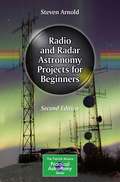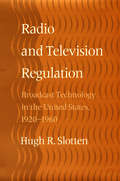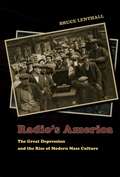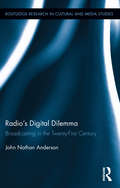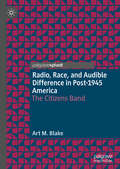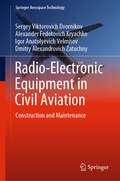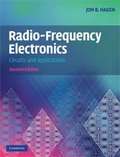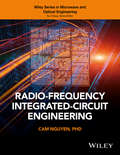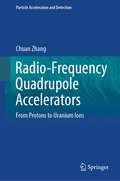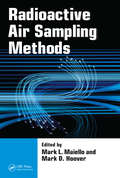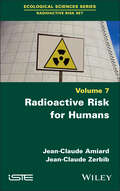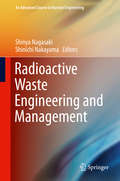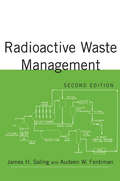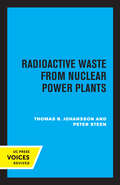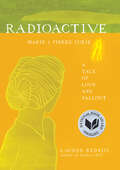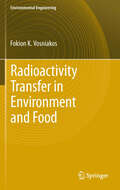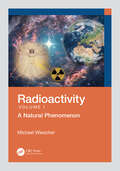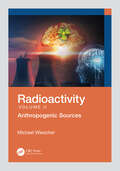- Table View
- List View
Radio and Radar Astronomy Projects for Beginners (The Patrick Moore Practical Astronomy Series)
by Steven ArnoldRadio and radar astronomy are powerful tools when studying the wonders of the universe, yet they tend to mystify amateur astronomers. This book provides a comprehensive introduction to newcomers, containing everything you need to start observing at radio wavelengths.Written by a mechanical engineer who has actually built and operated the tools described, the book contains a plethora of tested advice and practical resources. This revised edition of the original 2014 book Getting Started in Radio Astronomy provides a complete overview of the latest technology and research, including the newest models and equipment on the market as well as an entirely new section on radio astronomy with software-defined radios (SDRs). Four brand-new beginner projects are included, including bouncing a radar signal off the Moon, detecting the aurora, and tuning into the downlink radio used by astronauts aboard the ISS. Requiring no previous knowledge, no scary mathematics, and no expensive equipment, the book will serve as a fun and digestible reference for any level of astronomers hoping to expand their skills into the radio spectrum.
Radio and Television Regulation: Broadcast Technology in the United States, 1920-1960
by Hugh R. SlottenFrom AM radio to color television, broadcasting raised enormous practical and policy problems in the United States, especially in relation to the federal government's role in licensing and regulation. How did technological change, corporate interest, and political pressures bring about the world that station owners work within today (and that tuned-in consumers make profitable)? In Radio and Television Regulation, Hugh R. Slotten examines the choices that confronted federal agencies—first the Department of Commerce, then the Federal Radio Commission in 1927, and seven years later the Federal Communications Commission—and shows the impact of their decisions on developing technologies.Slotten analyzes the policy debates that emerged when the public implications of AM and FM radio and black-and-white and color television first became apparent. His discussion of the early years of radio examines powerful personalities—including navy secretary Josephus Daniels and commerce secretary Herbert Hoover—who maneuvered for government control of "the wireless." He then considers fierce competition among companies such as Westinghouse, GE, and RCA, which quickly grasped the commercial promise of radio and later of television and struggled for technological edge and market advantage. Analyzing the complex interplay of the factors forming public policy for radio and television broadcasting, and taking into account the ideological traditions that framed these controversies, Slotten sheds light on the rise of the regulatory state. In an epilogue he discusses his findings in terms of contemporary debates over high-resolution TV.
Radio in Revolution: Wireless Technology and State Power in Mexico, 1897–1938 (The Mexican Experience)
by J. Justin CastroLong before the Arab Spring and its use of social media demonstrated the potent intersection between technology and revolution, the Mexican Revolution employed wireless technology in the form of radiotelegraphy and radio broadcasting to alter the course of the revolution and influence how political leaders reconstituted the government.Radio in Revolution, an innovative study of early radio technologies and the Mexican Revolution, examines the foundational relationship between electronic wireless technologies, single-party rule, and authoritarian practices in Mexican media. J. Justin Castro bridges the Porfiriato and the Mexican Revolution, discussing the technological continuities and change that set the stage for Lázaro Cárdenas’s famous radio decree calling for the expropriation of foreign oil companies. Not only did the nascent development of radio technology represent a major component in government plans for nation and state building, its interplay with state power in Mexico also transformed it into a crucial component of public communication services, national cohesion, military operations, and intelligence gathering. Castro argues that the revolution had far-reaching ramifications for the development of radio and politics in Mexico and reveals how continued security concerns prompted the revolutionary victors to view radio as a threat even while they embraced it as an essential component of maintaining control.
Radio over Fiber for Wireless Communications: From Fundamentals to Advanced Topics (Wiley - IEEE)
by Xavier N. FernandoA comprehensive evaluation of Fi-Wi, enabling readers to design links using channel estimation and equalization algorithms This book provides a detailed study of radio over fiber (ROF) based wireless communication systems, otherwise called fiber wireless (Fi-Wi) systems. This is an emerging hot topic where the abundant bandwidth of optical fiber is directly combined with the flexibility and mobility of wireless networks to provide broadband connectivity. Its application is increasing because of the growing demand for broadband wireless services. In such a system the transmission of the radio signals over a fiber is an important task. This book provides substantial material on the radio over fiber part of the complete fiber-wireless system, including new research results on the compensation methods. The early chapters provide fundamental knowledge required for a non-expert engineering professional as well as senior/graduate level students to learn this topic from scratch. The latter part of the book covers advanced topics useful for researchers and senior students. Therefore, this book provides a comprehensive understanding of the system for readers who will gain enough knowledge to design Fi-Wi links of their own by learning how to develop Fi-Wi channel estimation and equalization algorithms. This concept is completely novel in current literature and has been patented by the author. Readers are expected to have a basic understanding of fiber optics and wireless communications to easily follow the book and to appreciate the concepts. Basics of the Fi-Wi system and signal processing approaches are clearly explained. It covers a multidisciplinary topic and acts as a bridge between optical and wireless communication domains. In the increasingly demanding telecommunications profession, engineers are expected to have knowledge in both optical and wireless communications and expected design combined/hybrid systems. Hence, the book is written in such a way that both optical and wireless professionals will be able to easily understand and perceive the concepts. follows a logical process from basic principles through to advanced topics, providing a wide range of interest for researchers, practicing engineers, students, and those required to build such networks explains detailed system design concepts and the limitations and advantages in each configuration, appealing to design engineers, and largely avoiding system specifics demonstrates the author’s exclusive patent, showing how to develop baseband signal processing algorithms for Fi-Wi systems, which is a key requirement for the successful deployment of Fi-Wi systems contains tables, numerical examples and case studies, facilitating a good quantitative understanding of the topic
Radio's America: The Great Depression and the Rise of Modern Mass Culture (Studies In Communication, Media, And Public Opinion Ser.)
by Bruce LenthallOrson Welles’s greatest breakthrough into the popular consciousness occurred in 1938, three years before Citizen Kane, when his War of the Worlds radio broadcast succeeded so spectacularly that terrified listeners believed they were hearing a genuine report of an alien invasion—a landmark in the history of radio’s powerful relationship with its audience. In Radio’s America, Bruce Lenthall documents the enormous impact radio had on the lives of Depression-era Americans and charts the formative years of our modern mass culture. Many Americans became alienated from their government and economy in the twentieth century, and Lenthall explains that radio’s appeal came from its capability to personalize an increasingly impersonal public arena. His depictions of such figures as proto-Fascist Charles Coughlin and medical quack John Brinkley offer penetrating insight into radio’s use as a persuasive tool, and Lenthall’s book is unique in its exploration of how ordinary Americans made radio a part of their lives. Television inherited radio’s cultural role, and as the voting tallies for American Idol attest, broadcasting continues to occupy a powerfully intimate place in American life. Radio’s America reveals how the connections between power and mass media began.
Radio's Digital Dilemma: Broadcasting in the Twenty-First Century (Routledge Research in Cultural and Media Studies #60)
by John Nathan AndersonRadio's Digital Dilemma is the first comprehensive analysis of the United States’ digital radio transition, chronicling the technological and policy development of the HD Radio broadcast standard. A story laced with anxiety, ignorance, and hubris, the evolution of HD Radio pitted the nation’s largest commercial and public broadcasters against the rest of the radio industry and the listening public in a pitched battle over defining the digital future of the medium. The Federal Communications Commission has elected to put its faith in "marketplace forces" to govern radio’s digital transition, but this has not been a winning strategy: a dozen years from its rollout, the state of HD Radio is one of dangerous malaise, especially as newer digital audio distribution technologies fundamentally redefine the public identity of "radio" itself. Ultimately, Radio’s Digital Dilemma is a cautionary tale about the overarching influence of economics on contemporary media policymaking, to the detriment of notions such as public ownership and access to the airwaves—and a call for media scholars and reformers to engage in the continuing struggle of radio’s digital transition in hopes of reclaiming these important principles.
Radio, Race, and Audible Difference in Post-1945 America: The Citizens Band
by Art M. BlakeIn the second half of the twentieth century, new sounds began to reverberate across the United States. The voices of African-Americans as well as of women, Latinx, queer, and trans people broke through in social movements, street protests, and in media stories of political and social disruption. Postwar America literally sounded different. This book argues that new technologies and new mobilities sharpened American attention to these audibly coded identities, on the radio, on the streets and highways, in new music, and on television. Covering the Puerto Rican migration to New York in the 1950s, the varying uses of CB radio by white and African American citizens in the 1970s, and the emergence of audible queerness, Art M. Blake attunes us to the sounds of race, mobility, and audible difference. As he argues, marginalized groups disrupted the postwar machine age by using new media technologies to make themselves heard.
Radio-Electronic Equipment in Civil Aviation: Construction and Maintenance (Springer Aerospace Technology)
by Dmitry Alexandrovich Zatuchny Sergey Viktorovich Dvornikov Alexander Fedotovich Kryachko Igor Anatolyevich VelmisovThis book presents the maintenance of radio equipment and the principles of operation of various radio receiving devices in civil aviation. The main feature of this book is the fact that it covers almost all types of radio receivers currently used in radar, communication and navigation equipment of civil aviation. Special attention is paid to ensuring the sensitivity of the receiver, as well as noise suppression under various conditions. A detailed description of the set of methods for receiving signals, especially in the case of frequency telegraphy is presented. This book provides a detailed description of specific methods of signal processing with frequency modulation—the so-called threshold-lowering reception methods based on reducing the bandwidth to the detector part of the private reception path in combination with the principle of negative feedback. The material presented in this book follows a logical sequence with a large amount of illustrations.
Radio-Frequency Electronics: Circuits and Applications
by Jon B. HagenThis second, updated edition of the best-selling Radio-Frequency Electronics introduces the basic concepts and key circuits of radio-frequency systems. It covers the fundamental principles applying to all radio devices, from wireless single-chip data transceivers to high-power broadcast transmitters. This new edition is extensively revised and expanded throughout, including additional chapters on radar, digital modulation, GPS navigation, and S-parameter circuit analysis. New worked examples and end-of-chapter problems are included to aid and test understanding of the topics covered, as well as numerous extra figures to provide a visual aid to learning. Key topics covered include filters, amplifiers, oscillators, modulators, low-noise amplifiers, phase lock loops, transformers, waveguides, and antennas. Assuming no prior knowledge of radio electronics, this is a perfect introduction to the subject. It is an ideal textbook for junior or senior courses in electrical engineering, as well as an invaluable reference for professional engineers in this area.
Radio-Frequency Heating in Food Processing: Principles and Applications (Electro-Technologies for Food Processing Series)
by Juming Tang George B. Awuah Hosahalli S. RamaswamyThis book covers the fundamental science and engineering principles governing radio-frequency (RF) applications and provides a solid understanding of industrial RF unit design options, challenges, and opportunities for development. It explains the similarities, differences, advantages, and limitations of RF and microwave heating; discusses dielectric and thermo-physical properties; provides practical perspectives on industrial RF units used in manufacturing food products; examines RF-heating effects on microorganisms, enzymes, and food quality attributes; and explores RF-heating applications beyond food processing, such as waste treatment and counterfeit prevention.
Radio-Frequency Integrated-Circuit Engineering
by Cam NguyenRadio-Frequency Integrated-Circuit Engineering addresses the theory, analysis and design of passive and active RFIC's using Si-based CMOS and Bi-CMOS technologies, and other non-silicon based technologies. The materials covered are self-contained and presented in such detail that allows readers with only undergraduate electrical engineering knowledge in EM, RF, and circuits to understand and design RFICs. Organized into sixteen chapters, blending analog and microwave engineering, Radio-Frequency Integrated-Circuit Engineering emphasizes the microwave engineering approach for RFICs. * Provides essential knowledge in EM and microwave engineering, passive and active RFICs, RFIC analysis and design techniques, and RF systems vital for RFIC students and engineers * Blends analog and microwave engineering approaches for RFIC design at high frequencies * Includes problems at the end of each chapter
Radio-Frequency Quadrupole Accelerators: From Protons to Uranium Ions (Particle Acceleration and Detection)
by Chuan ZhangThis book guides readers into the realm of particle accelerators, which have served as indispensable tools for fundamental research, energy development, medical therapy, industrial applications, national security, etc., since 1924. Towards a new generation of high power proton and ion accelerators, challenges often come from space charge effects, which are most pronounced in low-velocity beams. This book focuses on Radio-Frequency Quadrupole (RFQ) accelerators, one of the most popular front-end structures for accelerator facilities, and their beam physics. Uncovering the limitations of the classic design methods, novel approaches to achieve efficient RFQ accelerators with high beam quality will be presented. In addition, new ideas for possible future developments, such as how to realize long RFQs with high performance and how RFQs can be applied for much higher beam-velocities to shorten large-scale accelerators, will be introduced. To provide a general overview of the research and development of RFQs accelerating particle species from protons to uranium ions, this book uses over 10 real examples developed or proposed in the twenty-first century for various facilities of different dimensions (from large scale e.g. a collider to small scale e.g. university experimental setups). With its rich content and comprehensive scope, this book is an invaluable reference for researchers and graduate students interested in RFQ accelerators and the intricacies of space charge physics in low-velocity beams.
Radioactive Air Sampling Methods
by Mark L. Maiello Mark D. HooverAlthough the field of radioactive air sampling has matured and evolved over decades, it has lacked a single resource that assimilates technical and background information on its many facets. Edited by experts and with contributions from top practitioners and researchers, Radioactive Air Sampling Methods provides authoritative guidanc
Radioactive Contamination of the Tokyo Metropolitan Area: Five Years after the Fukushima Nuclear Accident
by Hideo YamazakiThis book presents the 5-year monitoring of radioactive contamination in the Tokyo metropolitan area due to the Fukushima accident, covering radiation monitoring of soil, litter, river, water, seawater, aquatic sediments, fish and shellfish, and plants in urban areas. Based on spatial and temporal data, it evaluates the environmental radiation contamination of the Tokyo metropolitan following the first nuclear accident affecting an urban area since Chernobyl. Since little is known about the contamination in Kiev city, this data is particularly valuable, offering insights into the dynamics of radioactive contamination in metropolitan areas, which are of interest in relation to the behavior of radionuclides resulting not only from nuclear accidents but also from nuclear terrorism? As such, this book will be appeal to nuclear and radiation experts, environmental administration professionals and specialists in environmental protection groups, as well as student and academics in the related fields.
Radioactive Pollutant: Sources, Issues and Remediation (Environmental Science and Engineering)
by Nitish KumarThis book sheds light on the global environmental issue and proposes solutions to contamination through multi-disciplinary approaches. Radioactivity occurs naturally. Ionizing radiation has always been a threat to humans and all other living things on earth. While the average global readings could be a suitable benchmark for what must be deemed "normal," the natural level of radiation exposure varies by around an order of magnitude for different locations of the earth. Regardless of whether this degree of radiation exposure qualifies as innocuous, it cannot be avoided because some diseases may be caused by exposure to naturally occurring radiation. As a result, these natural exposures serve as the foundation for and comparison point for radiation protection principles such as dose limits or limitations. The majority of the ionizing radiation that the world's population is exposed to comes from natural sources The public receives maximum doses from nuclear sites that are now in normal operation those are typically two orders of magnitude below the background radiation. In industrialized nations, medical uses of radioactivity and ionizing radiation result in mean doses that are comparable to those from natural radiation, but individual doses vary greatly. This edited book brings together a diverse group of researchers to address the challenges posed by global mass poisoning caused by radionuclides. This book contains three sections. First section describes the different sources of radioactive pollutant in the environment. Second section explains the health risk linked to radioactive pollutant. Third section addresses sustainable remediation strategies of radioactive waste and the potential applications of recent biological technology in providing solutions. This book is a valuable resource to students, academics, researchers, and environmental professionals doing field work on management of radioactive waste throughout the world.
Radioactive Risk for Humans (ISTE Consignment)
by Jean-Claude Amiard Jean-Claude ZerbibOnce scientists discovered radioactivity, they soon recognized its dangers. However, the assessment of radioactive risk to humans is still the subject of heated debate. In this book, the authors present a summary of past and recent scientific work on estimating radioactivity in the anthroposphere and the radioactive contamination of human beings. They describe the various sources of exposure to ionizing radiation (external, internal and dietary) and estimate the irradiation doses suffered by humans under various conditions (both naturally occurring for the general public and professionals, and from accidents). The harmful effects of ionizing radiation at various biological levels (molecular, cellular and tissue) and health effects at the individual level are also discussed. Particular focus will be placed on radiation-induced occupational illnesses. The relationship between doses of ionizing radiation and its harmful effects is discussed with reference to high, medium and low doses. The controversies on this subject are outlined, and international and French regulatory values are provided. Finally, an estimate of the radioactive risk for humans is suggested.
Radioactive Substances: Thesis Presented To The Faculte Des Sciences De Paris (classic Reprint)
by Marie CurieThe pioneering scientist&’s doctoral thesis on radioactivity that won her the 1903 Nobel Prize in Physics. In 1896, Antoine Henri Becquerel discovered the first evidence of radioactivity. Inspired by the physicist&’s work, Marie Curie began investigating this phenomenon further with the help of her husband, Pierre. For four years, the couple researched various minerals and substances for radioactivity, a term she coined. In Radioactive Substances,Curie outlines with great detail her painstaking research and discoveries, which include the elements radium and polonium. Due to their breakthroughs, Marie and Pierre were awarded the Nobel Prize in Physics in 1903, the first of two for Marie.
Radioactive Waste Engineering and Management
by Shinya Nagasaki Shinichi NakayamaThis book describes essential and effective management for reliably ensuring public safety from radioactive wastes in Japan. This is the first book to cover many aspects of wastes from the nuclear fuel cycle to research and medical use, allowing readers to understand the characterization, treatment and final disposal of generated wastes, performance assessment, institutional systems, and social issues such as intergenerational ethics. Exercises at the end of each chapter help to understand radioactive waste management in context.
Radioactive Waste Management
by James SalingThis reviews sources of radioactive waste and introduces radioactive decay and radiation shielding calculations. It covers technical and regulatory aspects of waste management with discussion questions at the end of each chapter to provide an opportunity to explore the many facets of waste management issues. An extensive reference list at the end of each chapter retains the references from the first edition of the book and incorporates references used in preparing this revised text, giving readers an opportunity to look at historical records as well as current information.
Radioactive Waste from Nuclear Power Plants
by Peter Steen Thomas B. JohanssonThis title is part of UC Press's Voices Revived program, which commemorates University of California Press’s mission to seek out and cultivate the brightest minds and give them voice, reach, and impact. Drawing on a backlist dating to 1893, Voices Revived makes high-quality, peer-reviewed scholarship accessible once again using print-on-demand technology. This title was originally published in 1981.
Radioactive: Marie & Pierre Curie: A Tale of Love and Fallout
by Lauren RednissA visual journey into the life of Marie Curie, as told through the dazzling collage style of acclaimed author and artist Lauren Redniss “Lauren Redniss creates an entirely new genre of biography.” —Nylon“Visually dazzling…a startlingly original graphic style.” —SlateThe name Marie Curie is enshrined in every schoolchild’s mind as one of the earliest and most inspirational female pioneers in the history of science. Yet the rich, vivid, and romantic story of Marya Salome Sklodwska—the young Polish national who discovered radioactivity—has been lost to time . . . until now, in the pages of this stunning, wildly creative, and uniquely moving visual biography by one of the most creative artistic talents working today. Lauren Redniss, a celebrated New York Times illustrator and storyteller, has thrown herself deeply and passionately into researching the story of the real Marie Curie; of her passionate and tragic romantic life; and of the century of scientific innovation and controversy that sprang from her discovery of radium and went on to change the course of world history. Drawing on her original archival research in Europe and the United States—and a host of new interviews with Curie family members and scientists who carry on the Curie tradition—Redniss has created a fascinating and deeply moving book. A visually stunning work of illustrative art, Radioactive walks the reader through the story of Curie’s own life, which was marked by both extraordinary scientific discovery and dramatic personal trauma—from her romantic partnership with Pierre, through his tragic decline from radium poisoning and death in a traffic accident, to the scandalous affair with another fellow scientist that almost cost her her second Nobel Prize. But it also casts an eye forward, to survey the changes wrought by Curie’s discovery of radioactivity—illuminating the path from the Curie laboratory past the bright red mushroom clouds in the Nevada desert through Three Mile Island and the advance in radiation therapy and nuclear power today. Whether young or old, scientific novice or expert, no one will fail to be moved by Lauren Redniss’s eerie and wondrous evocation of one of history’s most intriguing figures.
Radioactive: Marie And Pierre Curie - A Tale Of Love And Fallout
by Lauren RednissIn 1891, 24-year-old Marie Sklodowska moved from Warsaw to Paris, where she found work in the laboratory of Pierre Curie, a scientist engaged in research on heat and magnetism. They fell in love. They took their honeymoon on bicycles. They expanded the periodic table, discovering two new elements with startling properties, radium and polonium. They recognized radioactivity as an atomic property, heralding the dawn of a new scientific era. They won the Nobel Prize. Newspapers mythologized the couple's romance, beginning articles on the Curies with "Once upon a time... " Then, in 1906, Pierre was killed in a freak accident. Marie continued their work alone. She won a second Nobel Prize in 1911, and fell in love again, this time with the married physicist Paul Langevin. Scandal ensued. Duels were fought.<P><P> In the century since the Curies began their work, we've struggled with nuclear weapons proliferation, debated the role of radiation in medical treatment, and pondered nuclear energy as a solution to climate change. In Radioactive, Lauren Redniss links these contentious questions to a love story in 19th Century Paris.<P> Radioactive draws on Redniss's original reporting in Asia, Europe and the United States, her interviews with scientists, engineers, weapons specialists, atomic bomb survivors, and Marie and Pierre Curie's own granddaughter.<P> Whether young or old, scientific novice or expert, no one will fail to be moved by Lauren Redniss's eerie and wondrous evocation of one of history's most intriguing figures.
Radioactivity Transfer in Environment and Food
by Fokion K. VosniakosThe book deals with various consequences of major nuclear accidents, such as in 1986 in Chernobyl and in 2011 in Fukushima. The public is extremely interested in learning more about the movements and risks posed by radiation in the environment related to food supply and food safety. Radionuclides are found in air, water, soil and even in us not only after nuclear accidents because they occur also in nature. Every day, we ingest and inhale radionuclides in our air and food and the water. This book provides a solid underpinning of the basic physical-chemistry and biogeochemistry of naturally occurring and anthrop radioactivity. The mechanisms of radioactive element transfer in the atmosphere, tropospheric and stratospheric diffusion of radioactivity, environmental contamination from accidents and the impact of atmospheric pollution on the food chain, soil and plants, are analyzed and the analytical methods are illustrated. The question of natural radioactivity concentration in building materials is addressed too. While the book contains many case studies and data for Greece, it is of general value. It contributes to the development of international environmentally safe standards and economically reasonable standard regulations based on justified radiological, social and economical legislation concepts.
Radioactivity: A Natural Phenomenon
by Michael WiescherThis book provides an accessible introduction to radioactivity. The first in a two-volume set, this volume is presented in two parts, covering radiation physics and natural radiation exposure.It first explores the discovery and physics of the phenomenon of radioactivity, covering the discovery of radioactive decay and the historical development of the physics and applications of radioactivity through to 1940. Chapters then present descriptive summaries of the physics of the atom and the atomic nucleus, mass and energy conditions, the nature of isotopes, and the different decay patterns. Chapter three discusses decay laws and introduces natural origins of radioactivity as well as methods for producing radioactive isotopes through nuclear reaction processes in reactor and accelerator. The book then provides an introduction on dosimetry, radiation chemistry and impact of radiation on biological systems.The second half of the book details natural radioactivity and the role of radioactivity in the formation of the planetary system and our Earth. The author describes how the inner radioactivity of our planet determines its dynamics and how it could have contributed to the origins of life. The volume concludes with an exploration of the external and internal radioactivity to which humans are exposed and their possible side effects.This book will be of interest to non-science undergraduate and physics graduate students alike, as well as to interested lay-people looking for an introduction to radioactivity. Key Features:- Written in an accessible style, to be understood by readers without a formal scientific education- Highly illustrated throughout- Authored by an expert in the field, drawing from decades of experience in experimental nuclear physics
Radioactivity: Anthropogenic Sources
by Michael WiescherThis book provides an accessible introduction to radioactivity. The second in a two-volume set, this volume is presented in two parts, covering its development and modern applications.It first explores the development and applications of technically enhanced natural radioactivity (TENR) and addresses nuclear energy sources, the fission and fusion processes, and the issues of radioactive fallout from nuclear weapon use and test programs. Later chapters explore the cutting-edge medical applications of radioactive materials in diagnostics and therapy, exploring nuclear medicine technologies such as x-ray tomography, brachytherapy, and positron emission tomography (PET). They also detail the broad range of applications of radioactive materials in industrial production processes, in the sterilization of tools and materials in the medical and the food industries, and in the analysis of art and archaeological material to analyse paintings and painting techniques to identify fakes and forgeries. The book concludes with a discussion of the societal impact and understanding of radioactivity, alongside detailing the underlying reasons for its negative preconceptions and the possible mitigation of these through better education and information practices.This book will be of interest to non-science undergraduate and physics graduate students alike, as well as to interested lay-people looking for an introduction to radioactivity.Key Features:- Written in an accessible style, to be understood by readers without a formal scientific education- Highly illustrated throughout- Authored by an expert in the field, drawing from decades of experience in experimental nuclear physics
